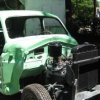Hello everyone,
I've been away from the forum for a long time, mostly because my Plymouth is done and I didn't drive it at all over the winter because our weather was so bad and there was salt on the roads for months and months. But I've been back on the road for the last few weeks and I've developed a problem:
The engine idles perfectly but when I accelerate, it surges. For example, if you open the throttle half way, the engine will accelerate and fade, accelerate and fade repeatedly. It does this in a perfect rhythm, like it's surging. It sounds to me like a carburetor problem, like maybe something wrong with the jet/plunger that allows you to accelerate. I will be pulling the air cleaner and examining the carb this weekend but I just wanted to check in quickly and see if anyone's had this problem and can point me to something specific. I'm going to watch for the stream of fuel down the throat of the carb when I accelerate as a first test. Like I said, it idles perfectly, but accelerating produces a surge that goes in a very regular cycle.


